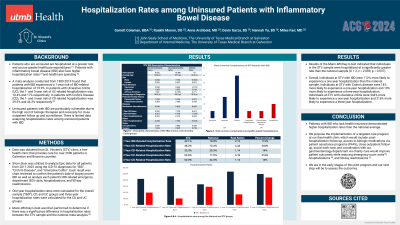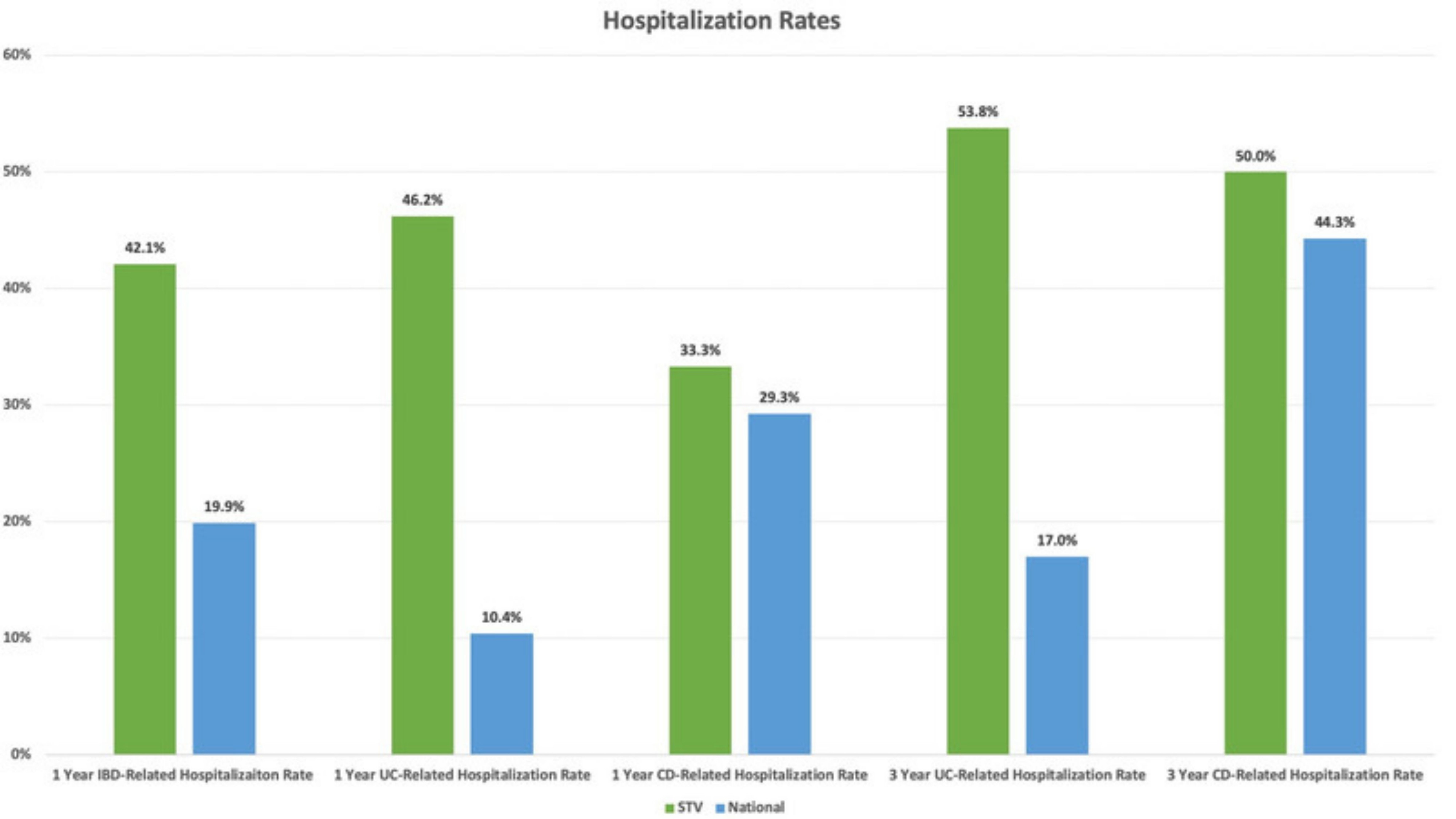Tuesday Poster Session
Category: IBD
P4301 - Hospitalization Rates Among Uninsured Patients With Inflammatory Bowel Disease
Tuesday, October 29, 2024
10:30 AM - 4:00 PM ET
Location: Exhibit Hall E

Has Audio
.jpg)
Garrett T. Coleman
University of Texas Medical Branch, John Sealy School of Medicine
Galveston, TX
Presenting Author(s)
Garrett T. Coleman, 1, Raakhi Menon, DO2, Anna Archbold, MD2, Devin Garza, BS2, Hannah Yu, BS2, Norman Farr, MD2
1University of Texas Medical Branch, John Sealy School of Medicine, Galveston, TX; 2University of Texas Medical Branch, Galveston, TX
Introduction: Patients who are uninsured are hospitalized at a greater rate and accrue greater healthcare expenditures. Patients with inflammatory bowel disease (IBD) face higher hospitalization rates and healthcare spending. Tsai et. al 2022 conducted a meta-analysis from 1980-2019 and found that patients with IBD experienced a 1-year risk of IBD-related hospitalization of 19.9%. In patients with Ulcerative Colitis (UC), the 1- and 3-year risk of UC-related hospitalization was 10.4% and 17% respectively. In patients with Crohn’s Disease (CD), the 1- and 3-year risk of CD-related hospitalization was 29.3% and 44.3% respectively. There is limited data analyzing hospitalization rates among uninsured patients with IBD.
Methods: Data was utilized from St. Vincent’s (STV), a free health clinic in Galveston, Texas. Slicer dicer analyzed Epic data for all patients from 2011-2023 using the ICD-10 diagnoses for “IBD”, “Crohn’s Disease”, and “Ulcerative Colitis” (Table 1). One-year hospitalization rates were calculated for the overall (“IBD”), CD, and UC groups and three-year hospitalization rates were calculated for the CD and UC groups (Fig. 1). Mann-Whitney U-test was then performed to determine if there was a significance difference in IBD-related hospitalization rates between the STV and national meta-analysis group.
Results: Results of the Mann-Whitney U-test demonstrated that individuals in the STV sample were hospitalized at a significantly greater rate than the national sample (U = 2, z = 2.089, p = 0.037). Overall, individuals at STV with IBD were 112% more likely to experience a hospitalization in one year than the national sample (RR = 2.12). Individuals at STV with CD were 14% more likely to experience a hospitalization in one year (RR = 1.14) and 13% more likely to experience a hospitalization over three years (RR = 1.13). Individuals at STV with UC were 344% more likely to experience a hospitalization in one year (RR = 4.44) and 216% more likely to experience a hospitalization over three years (RR = 3.16).
Discussion: Patients with IBD who lack health insurance demonstrated higher hospitalization rates than the national average. We propose the implementation of a targeted care program at our free health clinic which would include: post-hospitalization follow-up, access to biologic medications, close outpatient follow-up, social work care, and coordination with our gastroenterology department via charity care would improve patient outcomes while reducing emergency room visits and hospitalizations.

Note: The table for this abstract can be viewed in the ePoster Gallery section of the ACG 2024 ePoster Site or in The American Journal of Gastroenterology's abstract supplement issue, both of which will be available starting October 27, 2024.
Disclosures:
Garrett T. Coleman, 1, Raakhi Menon, DO2, Anna Archbold, MD2, Devin Garza, BS2, Hannah Yu, BS2, Norman Farr, MD2. P4301 - Hospitalization Rates Among Uninsured Patients With Inflammatory Bowel Disease, ACG 2024 Annual Scientific Meeting Abstracts. Philadelphia, PA: American College of Gastroenterology.
1University of Texas Medical Branch, John Sealy School of Medicine, Galveston, TX; 2University of Texas Medical Branch, Galveston, TX
Introduction: Patients who are uninsured are hospitalized at a greater rate and accrue greater healthcare expenditures. Patients with inflammatory bowel disease (IBD) face higher hospitalization rates and healthcare spending. Tsai et. al 2022 conducted a meta-analysis from 1980-2019 and found that patients with IBD experienced a 1-year risk of IBD-related hospitalization of 19.9%. In patients with Ulcerative Colitis (UC), the 1- and 3-year risk of UC-related hospitalization was 10.4% and 17% respectively. In patients with Crohn’s Disease (CD), the 1- and 3-year risk of CD-related hospitalization was 29.3% and 44.3% respectively. There is limited data analyzing hospitalization rates among uninsured patients with IBD.
Methods: Data was utilized from St. Vincent’s (STV), a free health clinic in Galveston, Texas. Slicer dicer analyzed Epic data for all patients from 2011-2023 using the ICD-10 diagnoses for “IBD”, “Crohn’s Disease”, and “Ulcerative Colitis” (Table 1). One-year hospitalization rates were calculated for the overall (“IBD”), CD, and UC groups and three-year hospitalization rates were calculated for the CD and UC groups (Fig. 1). Mann-Whitney U-test was then performed to determine if there was a significance difference in IBD-related hospitalization rates between the STV and national meta-analysis group.
Results: Results of the Mann-Whitney U-test demonstrated that individuals in the STV sample were hospitalized at a significantly greater rate than the national sample (U = 2, z = 2.089, p = 0.037). Overall, individuals at STV with IBD were 112% more likely to experience a hospitalization in one year than the national sample (RR = 2.12). Individuals at STV with CD were 14% more likely to experience a hospitalization in one year (RR = 1.14) and 13% more likely to experience a hospitalization over three years (RR = 1.13). Individuals at STV with UC were 344% more likely to experience a hospitalization in one year (RR = 4.44) and 216% more likely to experience a hospitalization over three years (RR = 3.16).
Discussion: Patients with IBD who lack health insurance demonstrated higher hospitalization rates than the national average. We propose the implementation of a targeted care program at our free health clinic which would include: post-hospitalization follow-up, access to biologic medications, close outpatient follow-up, social work care, and coordination with our gastroenterology department via charity care would improve patient outcomes while reducing emergency room visits and hospitalizations.

Figure: Figure 1 – One- and three-year hospitalization rates by subgroup (Inflammatory Bowel Disease, Ulcerative Colitis, and Crohn’s Disease) between the St. Vincent’s and national samples.
Note: The table for this abstract can be viewed in the ePoster Gallery section of the ACG 2024 ePoster Site or in The American Journal of Gastroenterology's abstract supplement issue, both of which will be available starting October 27, 2024.
Disclosures:
Garrett Coleman indicated no relevant financial relationships.
Raakhi Menon indicated no relevant financial relationships.
Anna Archbold indicated no relevant financial relationships.
Devin Garza indicated no relevant financial relationships.
Hannah Yu indicated no relevant financial relationships.
Norman Farr indicated no relevant financial relationships.
Garrett T. Coleman, 1, Raakhi Menon, DO2, Anna Archbold, MD2, Devin Garza, BS2, Hannah Yu, BS2, Norman Farr, MD2. P4301 - Hospitalization Rates Among Uninsured Patients With Inflammatory Bowel Disease, ACG 2024 Annual Scientific Meeting Abstracts. Philadelphia, PA: American College of Gastroenterology.
